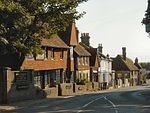St Mary's Church, Westham

St Mary's Church, Westham, is an active Anglican parish church in High Street, Westham, East Sussex, England, standing to the west of Pevensey Castle. The earliest fabric in the church, in the south wall of the nave and in the transept, dates from the late 11th century. The north aisle and the tower were added to the church in the late 14th century. The chancel was either rebuilt or remodelled in about 1420. During the 1870s restorations were carried out, including one by the Lancaster architects Paley and Austin in 1876–77, when the seating was increased from 297 to 403. The church is constructed in flint with stone dressings and a tiled roof. Its plan consists of a nave with a north aisle and a north porch, a south transept, a chancel with a north chapel, and a west tower. The tower contains six bells, the heaviest weighing over 10-1-10cwt (525kg) and being tuned to G major and being cast in 1921. The tenor bell, originally cast in 1789 and recast in 1921 with the other bells, is engraved with a war memorial, listing the bell ringers of the village lost during the Great War. The church has an active band of bell ringers, which is affiliated to the Eastern District of the Sussex Country Association of Change Ringers. Following the death of Queen Elizabeth II on 8th September the bells were rung fully muffled until the day after the state funeral on 19th September 2022, as part of Operation London Bridge.The church is recorded in the National Heritage List for England as a designated Grade I listed building.
Excerpt from the Wikipedia article St Mary's Church, Westham (License: CC BY-SA 3.0, Authors, Images).St Mary's Church, Westham
High Street, Wealden Westham
Geographical coordinates (GPS) Address Nearby Places Show on map
Geographical coordinates (GPS)
| Latitude | Longitude |
|---|---|
| N 50.8176 ° | E 0.3291 ° |
Address
High Street
BN24 5LL Wealden, Westham
England, United Kingdom
Open on Google Maps











